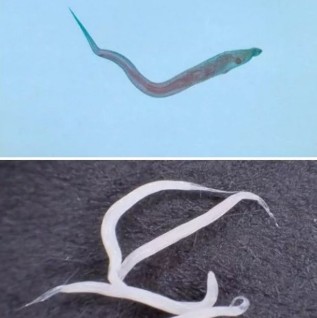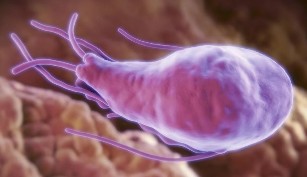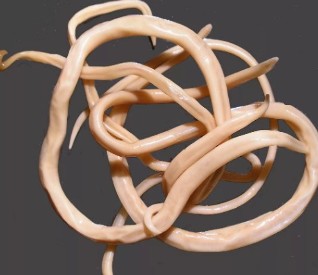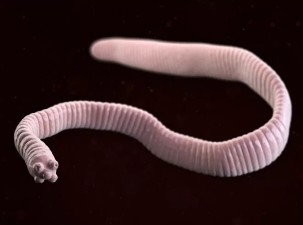Types of parasites in the human body is very diverse. One of them, along with many cell and protozoa are also viruses, bacteria and fungi that parasitize the human body, although in the medical traditions of viruses and bacteria are not considered parasites.

In the human body of different types of parasites are translated not only in the intestine, as is commonly believed, but also in many other organs: the blood, tissues, muscles, joints, brain (head and spine), and even in the eyes.
Particularly affected by this type of internal organs such as the gastrointestinal tract, the liver, the lungs, the heart.
Stay parasites in the human body is far from being innocuous. Harmful effects lies mainly in the fact that they absorb an important part of the diet nutrients, without which the full functioning of the organism impossible.
The imbalance is composed of the General management of the intoxication of the human body due to the toxins released by the parasites that can lead to the development of a number of diseases up to cancer. Often, diseases caused by parasites, become chronic.
A particular danger lies in the fact that parasitic diseases are caused by symptoms typical of other, often intestinal infections, therefore, of great importance is the timely differential diagnosis to identify the species of the parasite and to develop appropriate treatment strategy.
The species of human parasites in General can be divided into two major groups:
- ectoparasite, a parasite on the body surface and feeding on the blood of humans (bedbugs, fleas, lice, mites), which are the carriers of pathogens of such diseases as encephalitis, typhoid, anthrax, etc.;
- endoparasite parasitic on the internal organs and cause serious diseases, such as protozoa (Giardia, amoeba, Trichomonas, Toxoplasma) and helminths – parasitic worms (worms).
Classification of parasites

We consider the main types of endoparasites of man. The appearance of many of them can be seen only with a microscope, and some, especially helminths, affect its size. Let's start with the most simple:
- Giardia along with the liver also cause of hypovitaminosis, anemia, and General poisoning of the organism.
- Toxoplasma affect the brain, the eyes, the heart, the muscles, the nervous system, but the special danger they pose to pregnant women because of the risk of death fetal or serious injuries.
- The amoeba can cause amoebic dysentery, amoebic encephalitis and other dangerous diseases.
- Trichomonas are sources of infectious diseases of the genitourinary system.
The most common parasites
The most common endoparasite are, of course, helminths (worms), which, according to various estimates, infected more than 80% of the world population.
A large number of these parasites are divided into basic types:
- nematodes – round worms (roundworm, pinworm, Trichinella, whipworm, etc.);
- cestodes – tapeworms (lantecy, pork and beef tapeworm, Echinococcus, etc.);
- trematodes – worms-flukes (liver, blood, lung, and flukes that live in the intestines).
Sometimes, you can find more General classification, according to which all types of parasites, people are divided in:
- intestinal, parasites in the intestine;
- tissue, localized in other organs and tissues.
However, the majority of the worms in the different stages of its life cycle and the tissue, and intestinal development period with the corresponding symptoms.
Consider a brief description of the most common types of worms.
Worms (nematodes)
- Roundworm – roundworms are the most common length of 20 to 40 cm, parasites in the small intestine, but first migrate into the human body, which affect the blood and the respiratory system. Along with these intestinal parasites can be detected in the liver and the gallbladder, the heart and lungs. A common symptom of ascariasis and allergic reaction.
- Pinworms – small worms, up to 1 cm, which affects the intestine and lead to enterobiasis disorder of the gastrointestinal tract, fatigue, sleep disorders, etc. the Characteristic symptom of pinworms is itching in the anus, where they lay their eggs.
- Trichinella – these worms are microscopic (the size of only a few millimeters) lead to serious diseases – trichinosis, which can, if not treated lead to death. Adult species live in humans in the muscles (respiratory, face, etc.), causing muscle pain, fever, inflammation, allergic rash on the skin.
- Vlasoglavy – worms small (length up to 4.5 cm, with the front part of the body

The larvae that causes trichocephalosis with diarrhea, abdominal pain acute and other symptoms similar to appendicitis. As a result of poisoning of the anemia.
Tapeworms (cestodes)
- A had, the length of the body and reaching up to 10 m, leads to the development of difillobotrioz with nausea, weakness, vomiting, unstable chair, asthenia and anemia.
- The pork tapeworm has a length of 3 to 8 m, a parasite mainly in the small intestine and causes two diseases: taeniasis with dyspeptic, asthenic-neurotic and syndromes abdominal, and cysticercosis with intoxication, intestinal, allergic and respiratory symptoms. Depending on the location of tsistitserki affects the muscles, brain, heart, eyes, etc.
- Veal had, the length of which can reach up to 18 m, and means that the ox had infection is considered to be one of the most dangerous types of worms. If you do not deal with dehelmintization, that can stay in the body for 18-20 years! Is localized in the large intestine, causes severe poisoning with its waste products, as well as the diarrhea, nausea, vomiting, abdominal pain, anemia, allergic reactions and problems with the nervous system.
- Nan had only a length of 1.5-5 cm source gimenolepidoz with dyspeptic pain and astheno-neurotic syndromes that affect mainly the digestive system and the nervous system and the liver.
- Echinococcus is considered to be the smallest tape worm – its length is from 2.5 to 8, rarely 9 mm, but the infection has terrible consequences such as the liver and the lung, where they form cysts and tumors which cause dysfunction of these organs.

Worms-flukes (trematodes)
- Liver fluke or the liver Fluke has the form of a sheet with a length of 30 to 50 mm and a width of 8-13 mm, has a suction Cup. It damages the sheath of the liver and clog the bile ducts that is able to completely block the flow of bile. Can lead to cirrhosis, jaundice and liver cancer.
- Cat (Siberian) fluke cat, or a Fluke, flat worm with a length of 4-13 mm. Location – the ducts of the gallbladder, the liver and the pancreas. Causes opisthorchiasis with the development of gastritis, ulcers, pancreatitis, cholecystitis until cancer of the liver, which can lead to death.
- The lung fluke has a shape ovoid, red-brown body with small spines, length from 7.5 to 12 mm, with a width of 4-8 mm. Affects the lungs, causing inflammation, pleural effusion, focal fibrosis, and lung cancer. When the penetration into the brain, causing encephalitis and meningoencephalitis.
- Shistosoma (blood flukes) – dioecious worms with a size of 1-2 cm, the eggs of which lead to an increase in the liver, the spleen and lymph nodes, the formation of polyps in the bowel, diarrhea, granulomatous inflammation, leading to cancer of the bladder.
Sources of infection

Helminthiasis can lead to numerous health problems to reduce the life of 15-25 years. Many parasites are very difficult to detect. They can be anywhere - in the blood, the intestines, the lungs, the heart, the brain. The symptoms of worm infestation may be confused with SARS, gastrointestinal disease and others. The fundamental error in these cases the delay! If you are suspicious for the presence of parasites, you need to consult the specialist. If we talk about medications and self-treatment against the most common helminths (Ascaris, pinworms, tapeworms) suitable antiparasitic complex.
Helminthiasis, like other intestinal diseases, it is often a "disease of dirty hands", which leads to the accumulation of eggs and larvae of helminths in the human body:
- when you do not wash their hands after going to the toilet and before eating;
- do not wash the vegetables, the fruits and vegetables that are consumed raw;
- do not put meat and fish, sufficient heat treatment;
- incorrectly the consumption of salty fish and bacon;
- leave food accessible to flies and beetles;
- use the excrements as fertilizer in the garden plots;
- swimming in the pools;
- the contact with the street animals.

However, since your pet can also be infected with worms, because often the animals serve as intermediate hosts for helminths, but the primary host is man.
Methods of struggle
- From a very early age to instill in children the habit of washing your hands. Have to do more, since they constantly play in the sand, the dirt, puddles, where the most favourable conditions for the eggs and larvae of parasites, and contact with Pets and street animals.
- If you experience any discomfort, one can not exclude the bot, so it is recommended to perform the appropriate tests for parasites in order to identify a particular species of helminth (compared to most of them there are medications.
- If parasites are detected in a member of the family, the drugs, the bot must have all.
- Folk medicine knows many ways how to get rid of worms, and gave a good effect.
- Do not leave open cooked meals, bread, cakes, etc. which the flies or cockroaches carry eggs of intestinal worms – don't let them on the products.
- Carefully observe the temperature regime in the process of cooking: meat and fish, which are often found helminth eggs to boil/fry/bake.
- Rinse well with tap water vegetables, fruits, vegetables that are consumed raw.
- Regularly deworming Pets.
- To abandon the use of manure as fertilizer in their garden plots.
- When traveling to exotic countries extremely wary of the local cuisine, especially the street – there is no guarantee that they don't catch some exotic vermes.






































